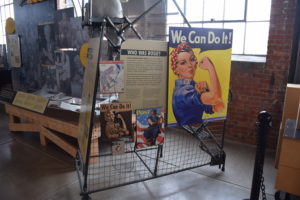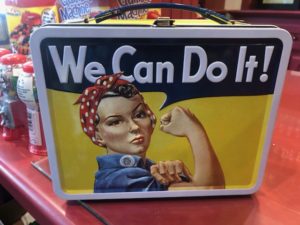By Donald H. Harrison

RICHMOND, California — Shortly after the Japanese bombed Pearl Harbor, Hawaii, on December 7, 1941, the United States went into full war mobilization mode. While many men were drafted into the U.S. Armed Forces, others were needed to staff the shipyards, aircraft factories, and munition plants on the home front. It soon became apparent that there were more positions to be filled than available male workers and so the U.S. began to recruit women to work in these war industries at jobs for which they never before had been eligible.
In 1942, John Jacob Loeb and Redd Evans collaborated on “Rosie the Riveter,” a song that both celebrated and came to symbolize the women who showed that they could not only do the jobs previously reserved for men but sometimes could do them even better.
The initial two stanzas of the song were:
While other girls attend their fav’rite cocktail bar
Sipping Martinis, munching caviar
There’s a girl who’s really putting them to shame
Rosie is her name
All the day long whether rain or shine
She’s a part of the assembly line
She’s making history,
working for victory
Rosie the Riveter
Subsequent versions of the song deemphasized what might have been considered class warfare by eliminating the first stanza, and inserting the sound of riveting into the tag line, so each stanza ended with “Rosie, (Brrrrrrrrrr) the riveter.”
The participation of John Jacob Loeb was one of the Jewish strands in the story of the women who riveted aircraft and welded ships during World War II.
Loeb went on to compose other popular songs such as “Seems Like Old Times,” “Sweetie Pie,” “A Sailboat in the Moonlight” and “The Maharajah of Magador” before he died at age 60 in 1970.
Richmond was the home of four Kaiser Shipyards, which, with three shifts enabling continuous work over a 24-hour period, could turn out “Liberty” cargo ships in record time; the SS Robert E. Peary, in fact, being manufactured in 4 days, 15 1/2 hours after the keel was laid. The ships were welded together from prefabricated sections.
Because Richmond contains more intact WWII “Home Front” sites than any other place in the U.S., it was chosen in 2000 to become the location of the “Rosie the Riveter/ World War II Home Front National Historic Park” on San Francisco Bay. There was irony in the choice because the ships were welded, not riveted. “Wendy the Welder” was an alternative cultural icon, but never was so popular as “Rosie.”

Besides the song, another reason for Rosie’s popularity was a Saturday Evening Post cover drawn by Norman Rockwell that showed a woman on her lunch break, a rivet gun in her lap next to a lunch box bearing the name Rosie. While seated she has one foot crushing a copy of Adolf Hitler’s Mein Kampf. She is posed in front of a U.S. flag backdrop.
In another irony, art historians noticed that the woman’s pose was similar to Michelangelo’s 1509 portrait of the prophet Isaiah, which appears on the ceiling of the Sistine Chapel in the Vatican. Isaiah is perhaps best known for his vision of a world that beats its swords into plowshares and knows war no more. Rosie symbolized the unfortunate reversal of that image; she knew not war until she was called upon to make its weapons.
Another image that came to be associated with Rosie was drawn in 1943 for a motivational Westinghouse poster by J. Howard Miller. It showed a woman wearing a bandana and flexing the muscle of her right arm under a rolled up sleeve. The caption on the poster was “We Can Do It.” The poster had faded into obscurity until the 1980s when it was rediscovered and popularized.
Henry J. Kaiser operated seven shipyards, four in Richmond, California; and the others in Oregon and Washington. In total they produced 1,490 ships for World War II. The industrialist is the same Kaiser whose name is associated with the Kaiser Permanente health maintenance organization, and therein is another Jewish strand in the American tapestry.
Under a system previously devised by Dr. Sidney Garfield, shipyard workers signed up for pre-paid medical plans, covering not only workplace accidents but general healthcare. After the war Garfield and Kaiser expanded their HMO, so that by 1990 it was the largest nonprofit HMO in the country.
In 1944, Republic Film Studios produced a comedy about Rosie the Riveter and a girlfriend having to share a room with a man, who worked on another shift. Housing was so scarce in Richmond at the time, that “hot bed” arrangements were not uncommon in which unrelated persons slept at different times in the same bed according to their work shifts. Actress Jane Frazee starred as Rosie.

Today, the J. Howard Miller image of the muscle-flexing, bandana-wearing Rosie remains popular. It can be found in novelty and souvenir stores, as well as at Zoonie’s candy store in Lafayette, California, where my son, the proprietor, sells metal lunch boxes emblazoned with the image.
Oliver B. Pollak, an emeritus history professor of the University of Nebraska-Omaha, who moved to Richmond with his wife Karen to be close to his children and grandchildren, has collected some of the Jewish connections to Rosie and the World War II production at the Kaiser Shipyards. Pollak is a regular contributor to San Diego Jewish World. Among his findings:
–Nora Mielke trained as a draftswoman. She worked in the Kaiser Shipyard #2 in an occupation often closed to both women and Jewish people. Nora was an architecture student at UC Berkeley during the day and worked in the shipyards at night. She was a member of Local 89 Technical Engineers, Architects, and Draftsmen. She did not pursue architecture after her contributions to the WWII Home Front but earned a teaching credential and worked in occupational therapy. She raised three children as a single mother in Berkeley. 73
—Fore N’ Aft, the shipyard’s monthly publication, featured the story of Fred (ne Fajwa) Hendeles who escaped Poland with his brother after the Nazi invasion. He made his way to Shanghai, China, then stowed away on the SS President Pierce in 1941 and arrived in October of that year in San Francisco. HIAS, then known as the Hebrew Immigrant Aid Society, helped him get a job at the Kaiser shipyard, where he started as a steamfitter. “It’s great to be in America,” Hendeles was quoted in the monthly magazine. “Suppose there were no America –what would happen to the rest of the world?”
–Ernst Werner Philipp was a Jewish artist who fled Germany and was hired by Kaiser in 1943 to paint the canvas “Building a Ship”
–Another Jewish worker at the shipyards was Joseph Benedikkt Fabry (ne Epstein) who escaped Austria and later wrote Swing Shift: Building the Liberty Ships which Warner Brothers made into a 1984 movie starring Goldie Hawn and Kurt Russell.
–On July 4, 1944, the SS Benjamin Warner was launched from the Kaiser Shipyard. The ship was named after the father of Hollywood’s Warner Brothers. The Benjamin Warner was the 1,147th Liberty Ship launched on the West Coast.
Besides the story of women in the workforce, the “Rosie the Riveter/ World War II Home Front National Historic Park” also has imaginative exhibits about life in Richmond during the war, and explores the experiences of African-Americans in the wartime industries, some dealing with discrimination, others finding measures of acceptance.
The National Park is located at 1414 Harbour Way South in Richmond. Admission is free.
*
Donald H. Harrison is editor of San Diego Jewish World. He may be contacted via donald.harrison@sdjewishworld.com